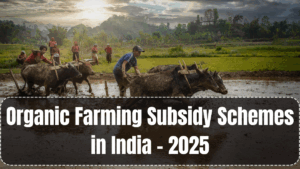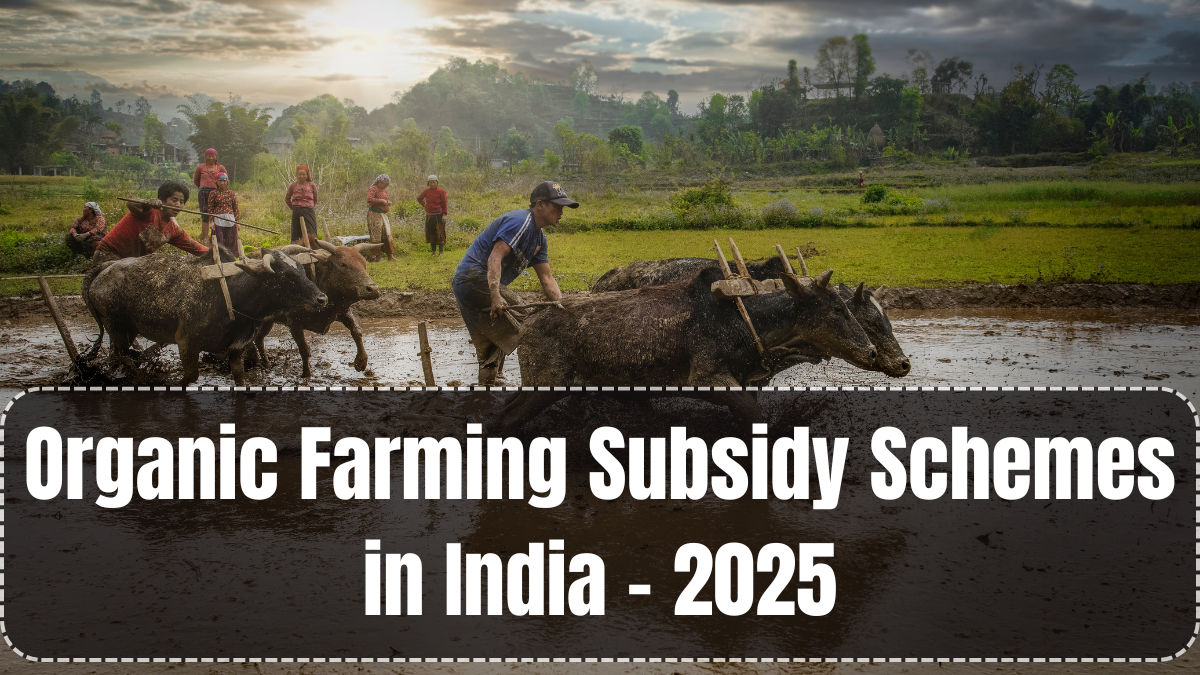India is witnessing a strong revival of natural and sustainable agriculture practices. With increasing consumer demand for chemical-free food, the government has introduced new financial incentives to support organic cultivation. The Organic Farming Subsidy 2025 brings focused assistance to farmers transitioning to organic methods, offering funding, certification support, and training under central and state-level schemes.
This initiative is a key part of India’s goal to reduce dependence on synthetic inputs, improve soil health, and promote export-quality organic produce. Whether you’re an individual farmer, a member of an FPO, or part of a tribal farming cluster — there’s support available in 2025.

Key Features of Organic Farming Subsidy 2025
The subsidy schemes introduced this year are more accessible, transparent, and inclusive. Major highlights include:
-
₹31,000 per hectare subsidy under PKVY for organic input management
-
100% support for cluster formation and training for farmer groups
-
Up to ₹1 lakh per FPO for setting up composting units
-
Reimbursement of costs for organic certification and branding
-
Incentives for organic input production units (biofertilizers, neem-based pesticides)
The Organic Farming Subsidy 2025 covers a wide range of expenses, making the organic transition financially viable for both smallholders and large farms.
Main Schemes Offering Organic Subsidies in 2025
Several central and state-backed schemes are driving this push for organic cultivation:
1. Paramparagat Krishi Vikas Yojana (PKVY)
-
Offered under the National Mission on Sustainable Agriculture
-
Focus on cluster-based organic farming
-
Subsidy of ₹31,000 per hectare for 3 years
-
Support for seeds, compost, bio-inputs, and field exposure visits
-
Direct Benefit Transfer (DBT) into farmer accounts
2. Mission Organic Value Chain Development (MOVCDNER)
-
Applicable to North-Eastern states only
-
Provides subsidies for inputs, certification, and packaging
-
Encourages export of organic produce
-
Helps in setting up collection centers and processing units
3. State-Specific Schemes
-
Madhya Pradesh: 50% subsidy on organic input production
-
Sikkim: Free organic kits to all certified farmers
-
Maharashtra: Cash incentive of ₹10,000/year per farmer under “Nisargik Sheti Abhiyan”
These schemes make up the backbone of the Organic Farming Subsidy 2025 structure.
Eligible Farmers and Crops
To avail of these subsidies, a farmer must:
-
Be registered with the local agriculture department or FPO
-
Have access to cultivable land (owned or leased)
-
Commit to zero chemical input use during the scheme duration
-
Use only certified organic inputs and follow cluster protocols
Commonly supported organic crops include:
-
Cereals (wheat, millets, paddy)
-
Pulses (moong, urad, tur)
-
Oilseeds (mustard, sunflower)
-
Spices (turmeric, ginger, black pepper)
-
Fruits and vegetables
Export-grade organic crops are prioritized under value chain support.
How to Apply for Organic Farming Subsidy
Farmers can apply for subsidies by following these steps:
-
Visit the official agriculture department website of your state or the PKVY portal
-
Go to the “Organic Farming Subsidy 2025” section
-
Fill out the registration form with Aadhaar, land details, and contact number
-
Upload required documents:
-
Aadhaar card
-
Land ownership/lease proof
-
Bank account passbook copy
-
Organic cluster or FPO membership ID (if applicable)
-
-
Submit and track the status through mobile SMS or online portal
Once verified, subsidy amounts are credited directly via Direct Benefit Transfer (DBT).
Support for Training and Certification
Besides financial help, farmers also receive free training through:
-
Krishi Vigyan Kendras (KVKs)
-
State Agriculture Universities (SAUs)
-
NGOs empanelled with PKVY
-
Digital video modules and WhatsApp groups in local languages
Additionally, certification costs (up to ₹15,000) are reimbursed under the Participatory Guarantee System (PGS-India), helping farmers market their produce as certified organic.
Market Access and Branding Support
The Organic Farming Subsidy 2025 also focuses on helping farmers:
-
Sell via APMCs and organic mandis
-
Connect with online marketplaces (Flipkart Organics, ONDC, BigBasket)
-
Receive packaging and labeling support
-
Participate in organic food exhibitions and export meets
This holistic approach ensures that subsidy is not just about cultivation, but also about sustainable income through proper market linkage.
FAQs
What is the subsidy amount provided under Organic Farming Subsidy 2025?
Under PKVY, farmers get ₹31,000 per hectare spread across 3 years, along with support for inputs, training, and certification.
Who can apply for these subsidies?
All registered farmers, FPOs, and tribal farmers transitioning to organic practices can apply.
Are subsidies available for certification costs?
Yes. Certification costs are reimbursed under PGS-India or NPOP schemes depending on the crop and location.
Which crops are eligible under organic farming schemes?
Subsidies cover cereals, pulses, oilseeds, vegetables, fruits, spices, and select commercial crops grown organically.
Can small landholders apply for this scheme?
Absolutely. Small and marginal farmers are a priority under both PKVY and MOVCDNER schemes.
Click here to know more.
